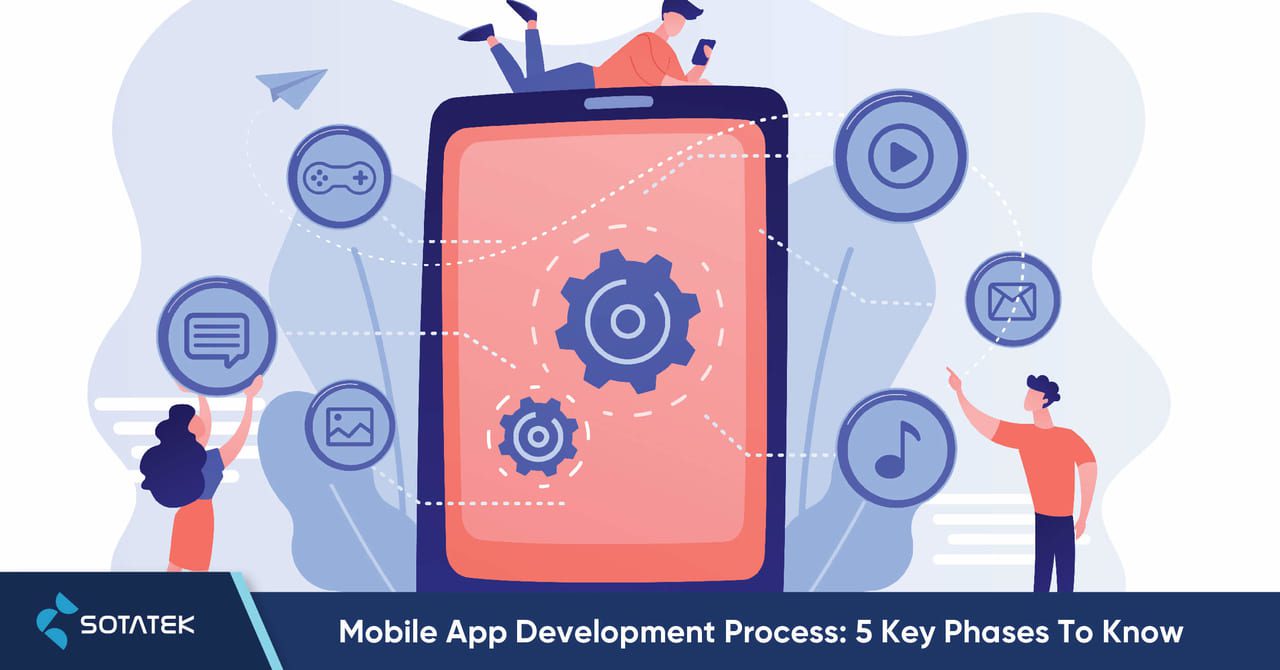In the digital world, almost all businesses from different industries, including Retail, eCommerce, Healthcare, Education, etc, are in need of building their own Mobile App to serve their operations as well as their customers. According to the App Annie 2017-2022 Forecast, the worldwide app downloads would increase to over 250 billion in 2022. Therefore, many are looking for an IT Outsourcing Partner to complete this task. Although the developers would take charge of all steps, and deliver full-cycle services, some business owners still want to know the overall Mobile App Development process. They may raise some questions related to “What is the Mobile App Development Process?” or “How to get started with Mobile App Development?”. To learn more about the 5 key phases in the process for Mobile App Development, let’s keep reading!
1. Analysis And Planning The Overall Mobile App Development Process
After receiving the clients’ requirements, the Mobile App Developer Team would have a further discussion to clarify the strategy and plan. This is considered an important step in the Mobile App Development Process as it would make sure that they are aware of the end user's needs as well as know their goals and is able to deliver their ideas. A product roadmap is also created to include prioritizing the mobile app requirements and combining them into delivery milestones.
In the planning phase, the Outsourcing team also figure out the necessary skills needed to finish that project. To be more specific, if the clients request an iOS platform, the team has to comprise the iOS developers who are competent in Objective-C and Swift. Similar to the Android App Development. Moreover, the name of the Mobile App is also identified in the first step. They would review every app store if possible to make sure the app name they’ve got isn’t taken.

The Mobile App Developer Team has a discussion to clarify the strategy and plan.
2. UI/ UX Design
Digital users nowadays not only want a beautiful app but also demand such Mobile App to run smoothly and be user-friendly. Therefore, UX (decides how the app works) and UI (defines how it looks) are both two important factors in the Mobile App Development process. This step includes creating: User Journey Map, Wireframes and Prototypes, Style Guides as well as Mockups.
- User Journey Map: It is the visualization of how the data or information of the app would show to the users as well as the way your customers would interact with it. Having a detailed workflow diagram would help the Mobile App Development team to find out all the feasible user interactions within the app and its navigation structure, which makes it easier to achieve the initial goals without being lost.
- Wireframes And Prototypes: Also known as low-fidelity mockups, wireframes are created to represent the application’s screens as they will look in real life. Designers would lay out the structure, hierarchy, and relationship between the elements that make up the product. Such wireframes are then used to build a clickable prototype - a dynamic, and interactive model of your Mobile App.
- Style Guides: Everything related to the visual of the Mobile App, such as text font, color pattern, motion design, etc, would be gotten mockups in this phase.
- Mockups: These mockups, which are considered high-fidelity designs, are built by combining the app’s wireframes and style guides.
3. App Development
It is believed to be the most active phase of the app development life cycle. Before starting the actual process of developing mobile apps, the team has to redefine the technical architecture, technology stacks, and other necessary information. Then, the development phase officially started! Normally, there are 3 integral parts to build, which are Back-End/Server Technology, API, and The Mobile App Front-End.
- Back-End/ Server Technology: This section includes essential database and server-side components to support the functionality of the app. Sometimes, the Mobile App Providers can utilize the existing back-end framework, and they just need to modify a little to suit the awaited mobile features.
- API: The API needs to be created to connect between the app and the back-end server or cloud storage.
- Mobile App Front-End: At this phase, the developers would code the graphical parts of software that users interact with. They can utilize any programming language that is suited for the operating system platform.
4. Testing And Quality Assurance For The Mobile App Development Process
A thorough Software Quality Assurance Testing in building a Mobile App is essential to ensure its reliability, usefulness, and security. Any software must go through the following testing procedures to deliver a quality mobility solution: User Experience Testing, Functional Testing, Performance Testing, Security Testing as well as Device and Platform Testing.
Actually, almost every Custom Software Development Company nowadays tends to adhere to Agile Methodology, a way to manage a project by breaking it up into several phases. It means that the bugs and errors in the mockup process or development process can be fixed immediately instead of putting QA off until later. This would somehow reduce the troubles you will encounter in the future and at the same time, save the budget for Mobile App Development costs.
Related: A Detailed Guide to Mobile App Development Cost
5. Deployment And Maintenance
After developing and testing carefully, it’s time for your Native Apps to publish on the Google Play or App Store. The app has to be submitted with some related information, such as the app’s name, icon, description, keywords, and privacy policy, depending on the requirements of each platform. Once the submission process is finished, your businesses should wait for a few days to release to the public as such platforms need to test whether your Mobile App complies with their rules or not.

After developing and testing carefully, it’s time to publish on the Google Play or App Store.
After the app is available on the platform, your businesses and brands should regularly check and receive feedback from users. If there are any bugs, any monitors needed, or simply need the update after a long time, feel free to contact your Software Providers. They would be happy to help you improve your app to stay attractive, adapt to changing market conditions, and users’ feedback.
6. Wrap Up: Starting Your Mobile App Development Process With SotaTek JSC
If you are finding a Top Software Outsourcing Company that can serve you from the beginning to the post-development process, SotaTek can be a good choice. As a leading SDaaS company with 8 global offices in Vietnam, Australia, the US, and Japan, we have been delivering Mobile App Development services for 6+ years to worldwide clients across different sectors. Our 600+ dedicated team always stays updated with the cutting-edge technologies, platforms as well as programming languages, with the aim to ensure each qualified software development project is built. So, contact us now, and we will help you to create an exclusively designed mobile app and guarantee a successful launch of your app as well.
Email: contact@sotatek.com
LinkedIn: https://www.linkedin.com/company/sota-tek-.-jsc/
Twitter: https://twitter.com/SotaTek



























